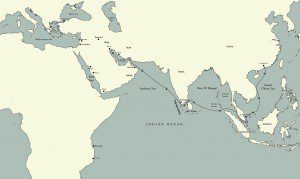Some years ago, in The Lost History of Christianity, I wrote about the world of Asian Christianity during the first millennium. Now, an amazing body of documents throws light on that lost world. This material also demonstrates how the Internet can make historical information freely available.
In the mid-ninth century, legal transactions were inscribed on a series of copper plates preserved at the great port of Kollam in southern India, modern Kerala. These have been known for many years, but a website now offers rich materials about the plates and their context.
The texts are of special interest for Christian history because one, at least, recorded a grant to a church, and it has been in the possession of that church ever since (!). In contemporary Europe, we would call it a charter.
I quote from the website:
Members of at least five world faiths (Hindus, Muslims, Christians, Zoroastrians and Jews) were present at the port speaking a wide range of languages and dialects and writing in their own distinctive scripts. One part of the document grants land and tax privileges to an Eastern Christian (or Nestorian) church and so gives an insight into the Christian community of 9th century Kollam. Christianity had been practised in south India since the 1st century CE and by the 9th century, the Eastern Christian church was well-established all across Asia. The church at Kollam maintained close links with Iran and the Gulf…. But we know that the church lands were bounded to the west by the sea, to the north by agricultural land and to the south-east by the palace walls. The document describes how the boundaries of the land were marked out by the ceremonial walking of a female elephant. This and other rituals were powerful visual signs of the legal process for the wider community of the port.
One part of the text reads as follows:
Any offence committed by the settlers in this land shall be dealt with by the men of the church alone. The men of the church alone shall collect fines for offences […]. None of our functionaries shall enter this land or the settlements claiming that an offence has been committed. The Six Hundred, the Ancuvannam and the Manigramam shall guard the church and the land.
The web material is part of a traveling exhibit that hit US shores in December. Forthcoming venues include:
3 Jan. – 7 Feb. 2014: Ball State University, Indiana.
14 – 28 Feb. 2014: University of the Sciences, Philadelphia.
3 – 28 March 2014: University of Pennsylvania, South Asia Studies.
7 Apr. to 2 May 2014 (tbc): University of Texas at Austin.
















